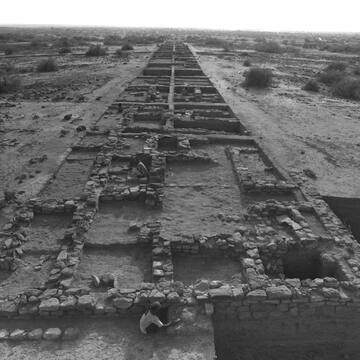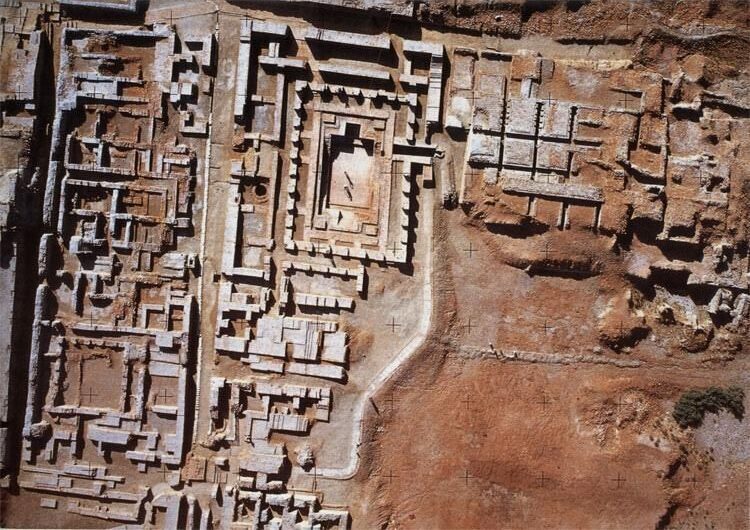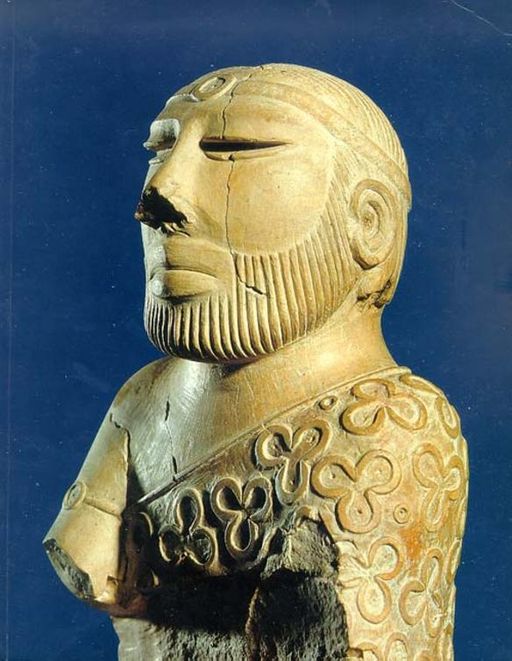ឥណ្ឌូស គឺជាអរិយធម៌ចំណាស់មួយក្នុងចំណោមបណ្តាអរិយធម៌ដំបូងៗទាំងបីលើពិភពលោកដែលក្នុងនោះមានដូចជា មេសូប៉ូតាមី អេហ្ស៊ីប និងឥណ្ឌូស ។ អរិយធម៌នេះមានការរីកចម្រើនចាប់ពីឆ្នាំ ២៦០០ ដល់ ១៩០០ ឆ្នាំ មុនគ.ស.នៅតំបន់អាស៊ីខាងត្បូង។
អរិយធម៌នេះមានការរីកចម្រើនខ្លាំងនៅតាមតំបន់ចន្លោះទន្លេពីរ គឺទន្លេឥណ្ឌូស និងទន្លេ Ghaggar-Hakra ដែលសព្វថ្ងៃស្ថិតនៅចន្លោះប្រទេសប៉ាគីស្ថាន និងប្រទេសឥណ្ឌា។ ហើយអរិយធម៌នេះក៏ជាដើមកំណើតរបស់អរិយធម៌ឥណ្ឌាផងដែរ។ គួរបញ្ជាក់ដែរថាការជ្រើសរើសតាំងទីនៅតាមតំបន់ទន្លេនេះ គឺមិនមែនចែដន្យនោះទេ គឺស្របទៅតាមវិស័យកសិកម្ម នេសាទ និងការចិញ្ចឹមសត្វដែលមនុស្ស ពឹងផ្អែកទៅលើប្រភពទឹកជាសំខាន់ ។
មនុស្សក្នុងអរិយធម៌ឥណ្ឌូសមានការលូតលាស់ខ្លាំងលើការរៀបចំក្រុង ដែលតាមរយៈការកំណាយបុរាណវិទ្យានៅឆ្នាំដើមទសវត្សទី៩០ ដោយអ្នកស្រាវជ្រាវអង់គ្លេសបានរកឃើញទីតាំងក្រុងបុរាណចំនួនពីរកន្លែងផ្សេងគ្នាមួយហៅថា Harappa និងមួយទៀតមានហៅថា Mohenjo-Daro ដែលមានន័យថាភ្នំនៃសេចក្តីស្លាប់ (Hill of Dead) ។ ទិន្នន័យនៃការកំណាយនៅទីតាំងទាំងពីរនោះ ត្រូវបានអ្នកស្រាវជ្រាវចាត់ទុកថា ជាទីក្រុងចំណាស់ជាងគេនៅក្នុងតំបន់អាស៊ីខាងត្បូងនេះ ដែលទីក្រុងទាំងពីរនោះប្រហែលជាកកើតនៅប្រមាណ 2000ជាងឆ្នាំ មុនគ.ស.។
ហើយការធ្វើកំណាយបុរាណវិទ្យានេះក៏បានបង្ហាញឱ្យឃើញពីរចនាសម្ព័ន្ធនៃការរៀបចំទីក្រុង Harappa និង Mohenjo-daro ដោយទីក្រុងទាំងពីរនេះមានកំពែងដីលើកព័ទ្ធជុំវិញ មានសំណង់សាធារណៈដូចជាអណ្តូងទឹក អាងទឹក ប្រព័ន្ធបង្ហូរទឹកផ្ទះប្រជាជន និងមានផ្លូវស្របតាមអក័្សបណ្តោយថ្ងៃ ទទឹងថ្ងៃ។ មនុស្សក្នុងសម័យអរិយធម៌នេះត្រូវបានគេកត់សម្គាល់ថា មានបច្ចេកទេសខ្ពស់ និងនយោបាយពាក់ព័ន្ធនឹងការរៀបចំដំណើរការកសាងទីក្រុងបុរាណ Harappa និង Mohenjo-daro ដែលមានប្រព័ន្ធធារាសាស្រ្ត ហេដ្នារចនាសម្ព័ន្ឋផ្សេងៗ។ គួរបញ្ជាក់ដែរថា មុននៃការរកឃើញ Harappa និង Mohenjo-daro ទីក្រុងទាំងពីរនេះ គឺកប់នៅក្រោមដីជ្រៅ ទើបនៅឆ្នាំ ១៩២១ និង ១៩២២ អ្នកស្រាវជ្រាវបានកំណាយសង្គ្រោះទ្បើងវិញ ។ ការរកឃើញទីក្រុង Mohenjo-daro គឺនៅឆ្នាំ ១៩២២ គេបានកំណាយលើទីតាំងចេតិយចាស់មួយដែលបានកសាងនៅលើកំពែងក្រុងនេះ ដែលចេតិយនោះប្រហែលកសាងនៅដើមមុនស.វ.ទី២នៃគ.ស.។
ចំពោះការគោរពប្រតិបត្តិសាសនា និងអក្សរវិញ យើងពុំបានដឹងច្បាស់លាស់នោះទេ តែឃើញមានបង្ហាញអក្សរ និងមានរូបចម្លាក់សត្វផ្សេងៗលើត្រា ដែលអ្នកស្រាវជ្រាវគិតទំនងជាអានពីស្តាំទៅឆ្វេង ដែលដូចនឹងភាសាក្នុងអម្បូរ ឥណ្ឌូ-អឺរ៉ុប និងឥណ្ឌាខាងត្បូង។ តាមរយៈរូបចម្លាក់ល្បីៗមួយចំនួនដូចជា រូបចម្លាក់ស្រី្តមានផ្ទៃពោះ រូបសត្វ ដែលបានរកឃើញនៅ Harappa និង Mohenjo-daro អ្នកស្រាវជ្រាវអាចគិតថា មនុស្សនៃអរិយធម៌នេះក៏មិនខុសអ្វីពីអរិយធម៌មេសូប៉ូតាមីដែរ ពោលការគោរពអទិទេពនៃការបង្កកំណើត។ ផ្ទុយពីអរិយធម៌ មេសូប៉ូតាមី និងអេហ្ស៊ីប អរិយធម៌ឥណ្ឌូស ហាក់បីដូចជាពុំសូវឃើញមានសំណង់ប្រាសាទ ឬសំណង់សាសនាផ្សេងៗដែលជាភស្តុតាងជាក់លាក់ក្នុងការបង្ហាញអំពីការគោរពប្រតិបត្តិ។
មនុស្សក្នុងអរិយធម៌នេះ មានជំនាញក្នុងការផលិតវត្ថុសិល្បៈ តាមទម្រង់ផ្សេងៗដែលបានរកឃើញពីកន្លែងជាច្រើន នៃអរិយធម៌នេះរួមមានរូបចម្លាក់ត្រា គ្រឿងស្មូនដី គ្រឿងអលង្ការ រូបចម្លាក់ដី អំពីថ្ម លោហៈធាតុ និងអំពីដីឥដ្ឋជាដើម។ ឧទា.រូបចម្លាក់ល្បីៗមួយចំនួនដូចជា រូបចម្លាក់ស្តេច Priestធ្វើអំពីថ្ម ដែលបានរកឃើញនៅ Mohenjo-Daro និងរូបស្ត្រីរបាំធ្វើអំពីសំរិទ្ឋ ជាដើម។
នៅឆ្នាំប្រមាណ ១៧០០មុនគ.ស. ទីក្រុងនៃអរិយធម៌ឥណ្ឌូសត្រូវបានគេបោះបង់ចោល។ អ្នកស្រាវជ្រាវជឿថាការបោះបង់នេះគឺ ប្រហែលមុនឆ្នាំ១៧០០ទៅទៀតបណ្តាលមកពីកត្តាជាច្រើនដែលធ្វើឱ្យអរិយធម៌មួយនេះធ្លាក់ចុះ ពោលមានដូចជាការបញ្ចប់ពាណិជ្ជកម្មជាមួយមេសូម៉ូតាមី និងអេហ្ស៊ីប កត្តាសង្គ្រាម និងជាពិសេសកតា្តធម្មជាតិដែលទឹកទន្លេឥណ្ឌូស និងទន្លេ Ghaggar-Hakra រីងស្ងួតដែលធ្វើឱ្យខ្វះប្រភពទឹកក្នុងជីវភាពរស់នៅប្រចាំថ្ងៃ។
———————————
Indus Civilization
Indus is one of the oldest three ancient civilizations in the world, including Mesopotamia, Egypt, and Indochina. This civilization flourished from 2600 to 1900 BC in South Asia and is situated between two rivers, the Indus and the Ghaggar-Hakra, which are now located between Pakistan and India. In addition, its location is along the river with potential for agriculture, fishing, and animal husbandry, where people rely mainly on water sources.
Based on archeological excavations in the early 1990s by British researchers found two different ancient city sites called Harappa and Mohenjo-Daro, which means Hill of Dead. Both sites are assumed by researchers to be the oldest city in South Asia, approximately 2000 BC.
Moreover, the archeological excavations also indicated the urban planning of Harappa and Mohenjo-Daro, which are surrounded by soil ramparts, with public structures such as wells, pools, drainage systems, and houses. The people are high knowledge of politics and technology in the construction of Harappa and Mohenjo-Daro as ancient cities, with an irrigation system and various infrastructures.
Individually, the practice of religion and using letters were identified through finding seals containing the letter and animal carving, thus researchers assuming are likely to read from right to left as similar as the languages tribe of Indo-European and South India. According to, the famous statues of pregnant women and animals found in Harappa and Mohenjo-Daro, researchers may assume that the people of this civilization were no different from the Mesopotamian civilization, that is, worshiping the deity of giving birth. However, the civilization of Mesopotamian, Egyptian, and Indus seem to have rarely seen temples or other religious structures as evidence of obedience.
There are many artifacts in various forms were found in many places of this civilization, including seals, pottery, jewelry, sculptures made from clay and stone, and metal, etc. For instance, some famous statues, such as the stone statue of Priest king and the bronze dancer woman found in Mohenjo-Daro, etc. The Indus city was abandoned approximately in 1700 BC. However, seven researchers believe that this abandonment was before 1700 BC due to many factors that led to the decline of this civilization, such as the end of trade with Mesopotamia and Egypt, War factors, and especially natural factors, cause the Indus and Ghaggar-Hakra rivers to dry up, leading to a shortage of water resources in daily life.
អត្ថបទដើម៖ លោក អេង តុលា











